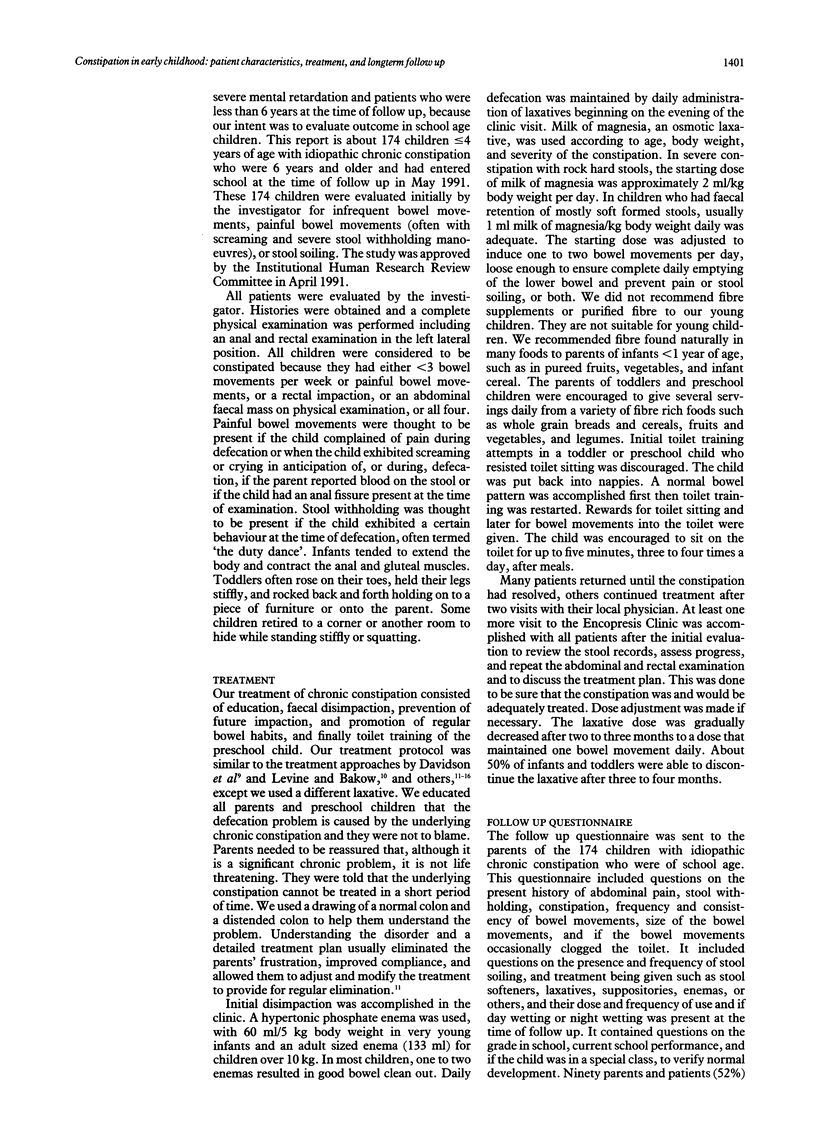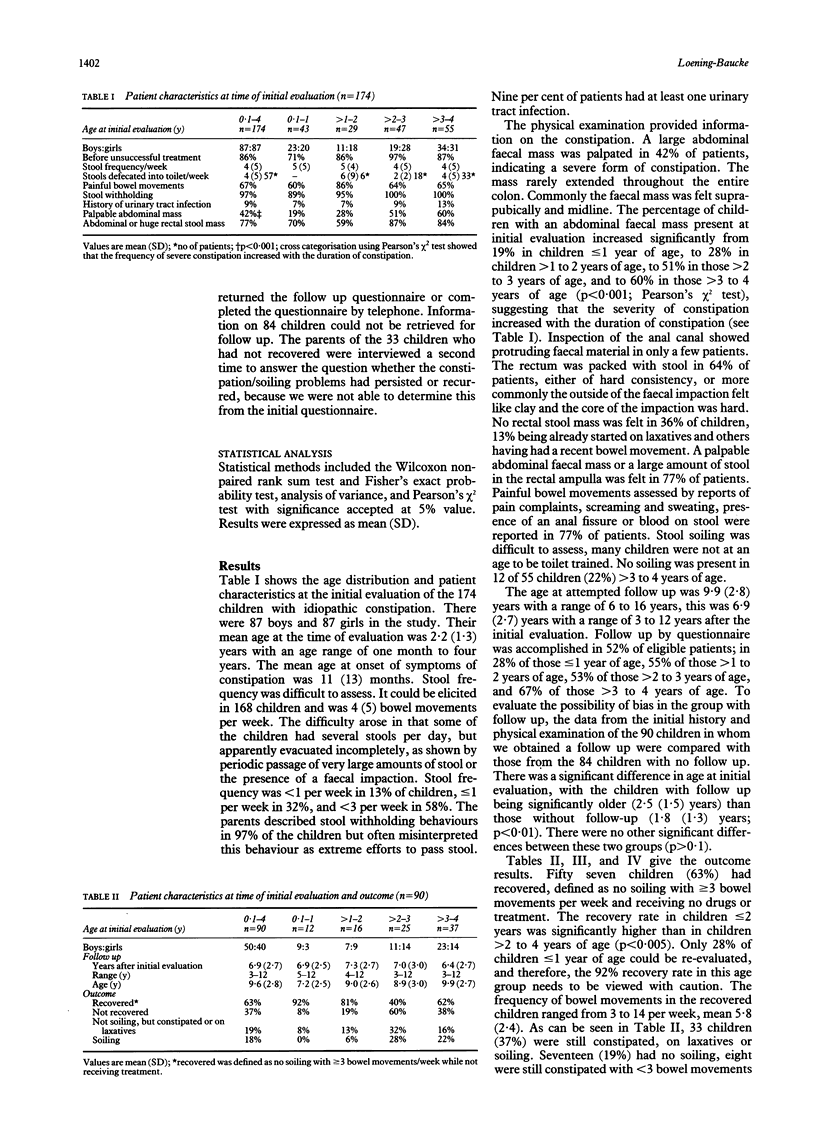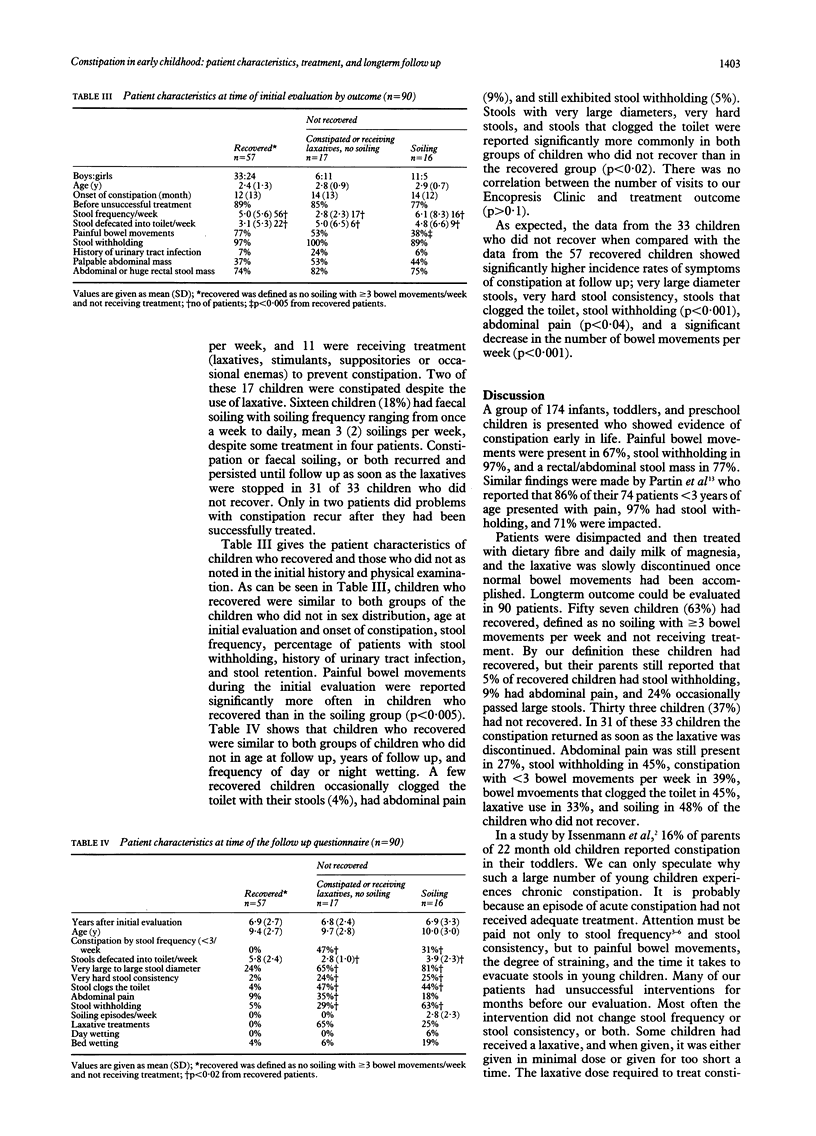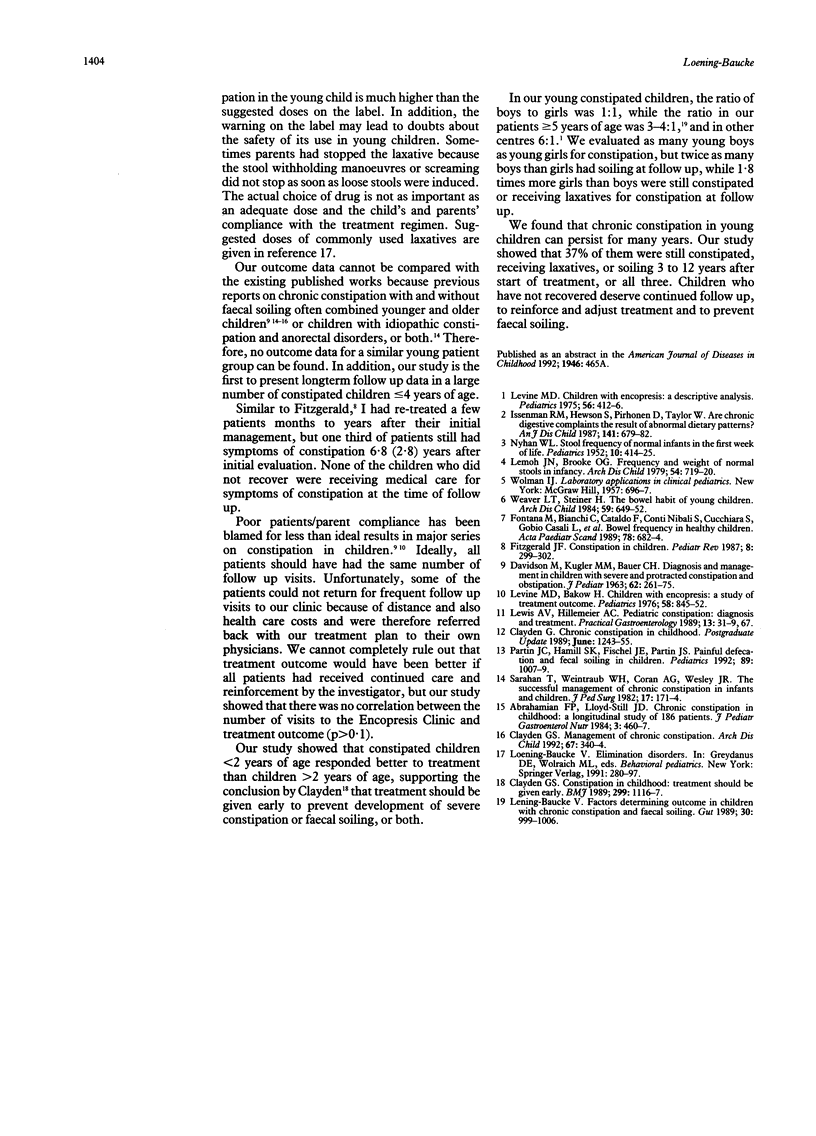Abstract
Little is known about chronic constipation in infants, toddlers, and preschool children and longterm outcome after treatment. The symptoms of 174 children < or = 4 years of age, who were evaluated for chronic constipation, are reported in this study together with the long-term outcome in 90 of them. Initial symptoms were infrequent bowel movements in 58%, painful bowel movements in 77% often with screaming, and severe stool withholding manoeuvres in 97%. The treatment of chronic idiopathic constipation consisted of education, faecal disimpaction, prevention of future impaction, and promotion of regular bowel habits with dietary fibre and milk of magnesia, and finally toilet training of the preschool child. Longterm outcome could be evaluated in 90 patients (52%) (mean (SD) 6.9 (2.7)) years after initial evaluation. Fifty seven children (63%) had recovered, defined as no soiling with > or = 3 bowel movements per week, while not receiving treatment. The recovery rate of children < or = 2 years of age was significantly higher than in children > 2 to 4 years of age. Thirty three children (37%) had not recovered. Constipation recurred as soon as laxatives were discontinued in 31 (94%) of them. Laxatives were still used by 33% of the children who had not recovered, 39% had < 3 bowel movements per week, 48% had faecal soiling, 45% had stool withholding, 27% complained of abdominal pain, 73% passed large stools, and 45% still on occasions clogged the toilet with their large stools. Symptoms of chronic constipation persisted in one third of our patients, 3-12 years after initial evaluation and treatment. Children who had not recovered deserve continued follow up, to reinforce and adjust treatment and to prevent faecal soiling.
Full text
PDF




Selected References
These references are in PubMed. This may not be the complete list of references from this article.
- Abrahamian F. P., Lloyd-Still J. D. Chronic constipation in childhood: a longitudinal study of 186 patients. J Pediatr Gastroenterol Nutr. 1984 Jun;3(3):460–467. doi: 10.1097/00005176-198406000-00027. [DOI] [PubMed] [Google Scholar]
- Clayden G. S. Constipation in childhood. BMJ. 1989 Nov 4;299(6708):1116–1117. doi: 10.1136/bmj.299.6708.1116. [DOI] [PMC free article] [PubMed] [Google Scholar]
- Clayden G. S. Management of chronic constipation. Arch Dis Child. 1992 Mar;67(3):340–344. doi: 10.1136/adc.67.3.340. [DOI] [PMC free article] [PubMed] [Google Scholar]
- DAVIDSON M., KUGLER M. M., BAUER C. H. Diagnosis and management in children with severe and protracted constipation and obstipation. J Pediatr. 1963 Feb;62:261–275. doi: 10.1016/s0022-3476(63)80404-7. [DOI] [PubMed] [Google Scholar]
- Fitzgerald J. F. Constipation in children. Pediatr Rev. 1987 Apr;8(10):299–302. doi: 10.1542/pir.8-10-299. [DOI] [PubMed] [Google Scholar]
- Fontana M., Bianchi C., Cataldo F., Conti Nibali S., Cucchiara S., Gobio Casali L., Iacono G., Sanfilippo M., Torre G. Bowel frequency in healthy children. Acta Paediatr Scand. 1989 Sep;78(5):682–684. doi: 10.1111/j.1651-2227.1989.tb11126.x. [DOI] [PubMed] [Google Scholar]
- Issenman R. M., Hewson S., Pirhonen D., Taylor W., Tirosh A. Are chronic digestive complaints the result of abnormal dietary patterns? Diet and digestive complaints in children at 22 and 40 months of age. Am J Dis Child. 1987 Jun;141(6):679–682. doi: 10.1001/archpedi.1987.04460060095043. [DOI] [PubMed] [Google Scholar]
- Lemoh J. N., Brooke O. G. Frequency and weight of normal stools in infancy. Arch Dis Child. 1979 Sep;54(9):719–720. doi: 10.1136/adc.54.9.719. [DOI] [PMC free article] [PubMed] [Google Scholar]
- Levine M. D., Bakow H. Children with encopresis: a study of treatment outcome. Pediatrics. 1976 Dec;58(6):845–852. [PubMed] [Google Scholar]
- Levine M. D. Children with encopresis: A descriptive analysis. Pediatrics. 1975 Sep;56(3):412–416. [PubMed] [Google Scholar]
- Loening-Baucke V. Factors determining outcome in children with chronic constipation and faecal soiling. Gut. 1989 Jul;30(7):999–1006. doi: 10.1136/gut.30.7.999. [DOI] [PMC free article] [PubMed] [Google Scholar]
- NYHAN W. L. Stool frequency of normal infants in the first week of life. Pediatrics. 1952 Oct;10(4):414–425. [PubMed] [Google Scholar]
- Partin J. C., Hamill S. K., Fischel J. E., Partin J. S. Painful defecation and fecal soiling in children. Pediatrics. 1992 Jun;89(6 Pt 1):1007–1009. [PubMed] [Google Scholar]
- Sarahan T., Weintraub W. H., Coran A. G., Wesley J. R. The successful management of chronic constipation in infants and children. J Pediatr Surg. 1982 Apr;17(2):171–174. doi: 10.1016/s0022-3468(82)80204-2. [DOI] [PubMed] [Google Scholar]
- Weaver L. T., Steiner H. The bowel habit of young children. Arch Dis Child. 1984 Jul;59(7):649–652. doi: 10.1136/adc.59.7.649. [DOI] [PMC free article] [PubMed] [Google Scholar]


